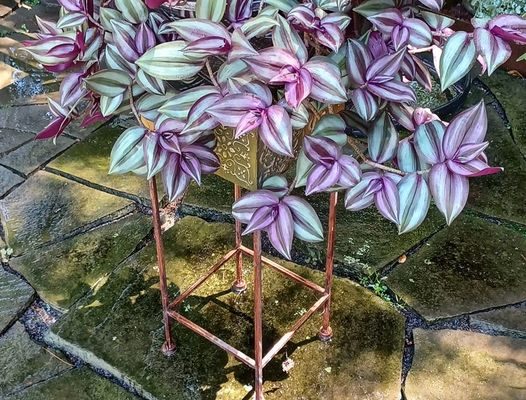Tradescantia pallida [trad-es-KAN-tee-uh, PAL-lid-duh] has striking purple evergreen leaves, providing a splash of color throughout the year.
The purple Tradescantia is part of the Tradescantia genus (spiderwort) of plants found throughout South and Central America, including northeast Mexico.

This tender evergreen perennial belongs to the Commelinaceae family, sometimes called the spiderwort or dayflower family.
Tradescantia pallida has several common names, including wandering Jew or walking Jew.
- Tradescantia fluminensis
- Tradescantia zebrina
Additional common names include:
- Purple Queen
- Purple heart plants
- Purple secretia
- Purple spiderwort
- Purple heart spiderwort
- Purple wandering jew
- Tradescantia purple heart
- These indicate the purple foliage and its heart-shaped leaves.
The common name Tradescantia purple heart refers to the fact that this plant is part of the spiderwort family.
In this article, we’ll delve into everything you need to know about proper purple heart wandering jew care.
Table Of Contents- Tradescantia Pallida Care
- How To Propagate Purple Heart Plant
- Purple Heart Plant Care: Pests or Diseases
- Suggested Tradescantia Pallida Uses
- More From The World Of Tradescantia
-
Tradescantia Pallida Care
Caring for Tradescantia pallida is relatively easy, making it a popular choice among gardeners and plant enthusiasts.

Size And Growth
Tradescantia pallida (synonym Setcreasea pallida) is a relatively delicate plant with thin stems. It grows in short mounds, reaching a height of just 8″ inches.
The trailing stems spread up to 18″ inches or more and produce shockingly purple evergreen leaves.
The v-shaped leaves are narrow and measure 4″ to 6″ inches long. When grown outdoors, this purple queen wandering jew can provide weedy ground covers.
The stems of Purple Heart are fragile, especially with younger plants. If kicked or stepped on, the stems may break.
Flowering And Fragrance
The spiderwort purple plant blooms throughout the warmer months, producing small, three-petaled flowers.
The small pink flowers rarely measure more than 1.5″ inches in diameter.
They appear in clusters and don’t produce a scent.
Light And Temperature
Tradescantia pallida purple heart grows best in partial shade and will tolerate full sun areas.
It shouldn’t receive direct afternoon sunlight for over an hour or two. Too much direct sunlight causes the leaves to fade or scorch.
While purple spiderwort Tradescantia thrives in the shade, full sun or bright lighting helps bring out the color in the purple leaves.
NOTE: If the plant receives a lot of sunlight, the soil should be kept moist.

The tender purple queen plant can’t survive freezing conditions.
It’s often grown in gardens as an annual in regions with mild climates and indoors as a houseplant in cooler areas.
The purple snake plant is winter hardy to USDA hardiness zones 10 and 11.
When grown indoors, it should receive filtered light for at least eight hours per day.
If possible, try to move the spiderwort purple plant outdoors during the warmer months of spring and summer to encourage brighter foliage.
Watering And Feeding
Water moderately during the warmer months and sparingly during the winter.

The purple heart plant is drought tolerant and thrives on neglect.
When watering, ensure there are adequate drainage holes to prevent root rot.
Lack of humidity can also result in brown leaf tips. You can encourage humidity by moving your plant into the bathroom when showering or using a humidifier.
Add a liquid fertilizer every four weeks throughout the spring and summer.
Soil And Transplanting
Grow tradescantia pallida in loamy soil. It should offer decent water retention and good drainage.
Add organic matter, such as peat moss, perlite, or compost, to improve the quality of regular garden soil and improve drainage.
If the soil is too rich, add small amounts of sand. Transplant as needed or every few years to refresh the soil.
Moreover, if the roots extend to the edge of its current container, repotting is needed.





